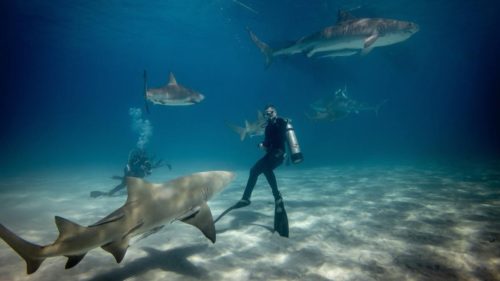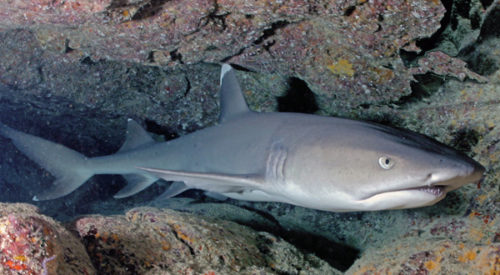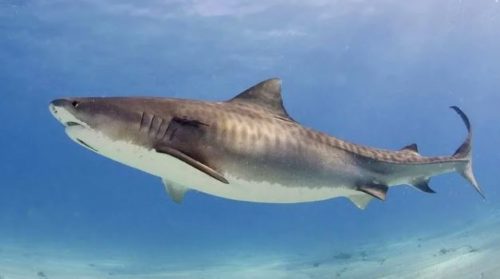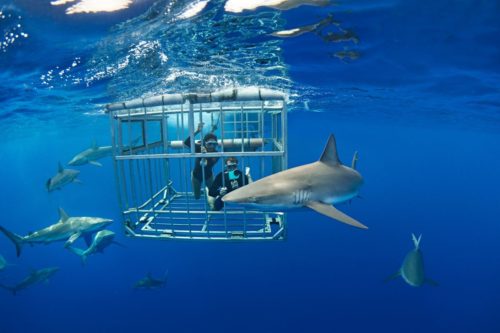The Hawaiian Islands is known for its incredible biodiversity surrounding all of its magnificent beaches. The waters off Oahu, Maui, or the Big Island contain precious ecosystems that harbor some of the most amazing sea creatures.
Endemic reef fish, manta rays, green sea turtles, humpback whales and, of course, spinner dolphins are some of the unique marine life that draw in tourists from all over the globe who come to snorkel and scuba dive.
With all kinds of amazing attractions, it’s obvious that Hawaii is a popular destination for scuba diving, Waikiki being a favorite —especially for the adventurous thrill-seeker. One of those unforgettable activities is swimming with sharks.
That’s because the Hawaiian archipelago is home to around 40 shark species. Shark encounters in places such as Maui and Oahu’s North Shore are practically guaranteed.

If you’re not an experienced scuba diver, then this rare opportunity is made possible by shark cage diving (an exhilarating activity that does not require a scuba certification).
Most common sharks in Hawaii
The most common shark species in Hawaii are whitetip reef sharks, oceanic blacktips, scalloped hammerheads, Galapagos, sandbars, blue sharks, and tiger sharks.
Each of these species are unique. Some tend to develop strong social connections and swim in groups (e.g., hammerheads, Galapagos) and others are passive creatures that prefer to mind their own business (e.g., sandbar sharks). Reef sharks, such as the whitetip and blacktip, are spotted in the clear waters of coral reefs.
One of the most aggressive species is the tiger shark. Although they can appear to be curious and respectful of divers, tiger sharks are responsible for the second-highest number of attacks on humans behind the great white.
Does Hawaii have great white sharks?
Great white shark sightings in Hawaii are quite rare. Despite its reputation as being the most aggressive shark species on the planet, the great white has never attacked a human in Hawaii.
This species tends to concentrate in the waters around Australia, South Africa, the Northeastern Pacific, and North Atlantic. Having said that, great white sharks are known to make remarkably long migrations which sometimes include the Hawaiian archipelago.

What sharks can you swim with in Hawaii?
If you plan on swimming or shark cage diving in Hawaii, you can expect to see at least three or four types of requiem sharks: the Galapagos, reef shark, sandbar, or tiger shark.
Galapagos shark
Wherever there are clear reef ecosystems near tropical islands, the Galapagos shark is typically one of the most abundant species. It is a large species (reaching 10 ft in length) that actively hunts prey in large groups. It has a wide, rounded snout and noticeably long dorsal and tail fins (with dark edges).
These traits, coupled with their inquisitive and tenacious behavior, are some of the reasons why you’ll likely encounter the Galapagos shark when cage diving.

Reef shark
The most common species you may encounter are the whitetip and blacktip reef sharks. These sharks are easily recognizable in the tropical coral reefs around the Hawaiian Islands where snorkeling and diving are popular.
The whitetip is recognizable by its short, broad head and slender body. It’s a relatively small shark around 5 ft. or less in length. The blacktip shark, about the same size as the whitetip, is recognizable by the black tips on its dorsal and tail fins.
Both species prefer to live in coral reefs and shallow, inshore waters. The whitetip is found near the seabed and spends a lot of time resting in caves during the day. But it’s actually quite curious and is not afraid to swim near humans. On the other hand, the blacktip shark is considered shy or skittish. Both species are relatively harmless to humans.

Sandbar shark
Also called the brown shark, this species inhabits the sandy seabeds of shallow coastal waters (such as bays and harbors)—the main reason why you might spot one while swimming in Hawaii. They will sometimes venture out into deeper waters of 500 ft. or more.
They are distinguishable by their very high dorsal fin, long pectoral fins, and heavy-set bodies. Females can grow up to 8 ft. in length. They typically have a bronze or brownish-gray color. They are not considered to be dangerous to humans.

Tiger shark
Last but not least, is the notorious tiger shark. With a reputation of taking a bite of almost anything floating in the ocean, they are the only “garbage eaters” in this list (and also classified as apex predators).
These nomadic creatures are guided by warmer waters and swim in deep tropical and subtropical waters near coastal reef zones. They often travel through the main Hawaiian islands such as Oahu and Maui.
Appearing blue to light green on top (with a light underbelly), tiger sharks have an average length of 10 to 14 ft. (the fourth largest shark species on average). They have long fins, a long upper tail, and uniquely sharp teeth with tips pointing sideways.

Is it safe to go in the water with sharks?
The simple answer is yes.
Most sharks prefer to eat small fish and do not instinctively view humans as a source of food. They tend to give divers some space because we look unfamiliar and may pose a threat to them.
In fact, shark attacks on humans (provoked or unprovoked) are very rare. Fatalities due to shark attacks are even rarer.

Shark cage diving is remarkably safe. There has never been a shark-related fatality (or even a bite) in a cage diving accident on record. Of course, people have gotten injured by slipping on the boat or bumping their heads against the cage. Very few adventurous activities are completely risk-free.
People who swim with sharks for the first time often remark on their incredible beauty and gracefulness (not to mention the otherworldly experience of floating in their natural habitat).
How much does it cost to go shark diving in Hawaii?
Swimming with sharks, such as shark cage diving, is very affordable given how extreme and unforgettable the experience can be to some people. You don’t even need to be scuba certified.
For most shark cage diving tours in Hawaii, the cost per adult ranges from $100 to $150 for up to 30 minutes in the water with the sharks. Some tours can last up to 2 hours round trip and may include “in cage” or “out of cage” experiences (such as freediving snorkeling).

Safety first
Even though shark diving is considered safe for the whole family, there are general safety guidelines that must be followed at all times. Tour operators simply won’t let you participate if you refuse to be safe (to the best of your ability):
- Stay out of the water if you are bleeding or have open wounds.
- Hold back on splashing or erratic movements.
- Try to avoid dark areas with low visibility.
- Stay away from dead animals that sharks may feed on.
- Don’t swim alone if possible.
- Try to wear dark or low-contrast clothing.
Most of these safety guidelines apply to freediving such as scuba or snorkeling. However, you should not go in the water if you are bleeding or have open wounds (including cage diving).
Although sharks may safely approach a dive cage out of curiosity, it is important not to deliberately provoke them into being aggressive.
